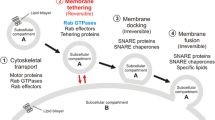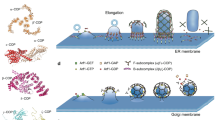Abstract
Conversion of the normal soluble form of prion protein, PrP (PrPC), to proteinase K-resistant form (PrPSc) is a common molecular etiology of prion diseases. Proteinase K-resistance is attributed to a drastic conformational change from α-helix to β-sheet and subsequent fibril formation. Compelling evidence suggests that membranes play a role in the conformational conversion of PrP. However, biophysical mechanisms underlying the conformational changes of PrP and membrane binding are still elusive. Recently, we demonstrated that the putative transmembrane domain (TMD; residues 111–135) of Syrian hamster PrP penetrates into the membrane upon the reduction of the conserved disulfide bond of PrP. To understand the mechanism underlying the membrane insertion of the TMD, here we explored changes in conformation and membrane binding abilities of PrP using wild type and cysteine-free mutant. We show that the reduction of the disulfide bond of PrP removes motional restriction of the TMD, which might, in turn, expose the TMD into solvent. The released TMD then penetrates into the membrane. We suggest that the disulfide bond regulates the membrane binding mode of PrP by controlling the motional freedom of the TMD.
Similar content being viewed by others
References
Baron, G.S., and Caughey, B. (2003). Effect of glycosylphosphatidylinositol anchor-dependent and -independent prion protein association with model raft membranes on conversion to the protease-resistant isoform. J. Biol. Chem. 278, 14883–14892.
Castilla, J., Saa, P., Hetz, C., and Soto, C. (2005). In vitro generation of infectious scrapie prions. Cell 121, 195–206.
Critchley, P., Kazlauskaite, J., Eason, R., and Pinheiro, T.J. (2004). Binding of prion proteins to lipid membranes. Biochem. Biophys. Res. Commun. 313, 559–567.
De Gioia, L., Selvaggini, C., Ghibaudi, E., Diomede, L., Bugiani, O., Forloni, G., Tagliavini, F., and Salmona, M. (1994). Conformational polymorphism of the amyloidogenic and neurotoxic peptide homologous to residues 106–126 of the prion protein. J. Biol. Chem. 269, 7859–7862.
Deleault, N.R., Harris, B.T., Rees, J.R., and Supattapone, S. (2007). From the cover: formation of native prions from minimal components in vitro. Proc. Natl. Acad. Sci. USA 104, 9741–9746.
Eftink, M.R., and Ghiron, C.A. (1981). Fluorescence quenching studies with proteins. Anal. Biochem. 114, 199–227.
Fanucci, G.E., and Cafiso, D.S. (2006). Recent advances and applications of site-directed spin labeling. Curr. Opin. Struct. Biol. 16, 644–653.
Forloni, G., Angeretti, N., Chiesa, R., Monzani, E., Salmona, M., Bugiani, O., and Tagliavini, F. (1993) Neurotoxicity of a prion protein fragment. Nature 362, 543–546.
Hegde, R.S., Mastrianni, J.A., Scott, M.R., DeFea, K.A., Tremblay, P., Torchia, M., DeArmond, S.J., Prusiner, S.B., and Lingappa, V.R. (1998). A transmembrane form of the prion protein in neurodegenerative disease. Science 279, 827–834.
Hegde, R.S., Tremblay, P., Groth, D., DeArmond, S.J., Prusiner, S.B., and Lingappa, V.R. (1999). Transmissible and geneti prion diseases share a common pathway of neurodegeneration. Nature 402, 822.
Horiuchi, M., and Caughey, B. (1999). Prion protein interconversions and the transmissible spongiform encephalopathies. Structure 7, R231–240.
Hubbell, W.L., McHaourab, H.S., Altenbach, C., and Lietzow, M.A. (1996). Watching proteins move using site-directed spin labeling. Structure 4, 779–783.
Hubbell, W.L., Cafiso, D.S., and Altenbach, C. (2000). Identifying conformational changes with site-directed spin labeling. Nat. Struct. Biol. 7, 735–739.
Jackson, G.S. (1999). Reversible conversion of monomeric human prion protein between native and fibrilogenic conformations. Science 283, 1935.
James, T.L., Liu, H., Ulyanov, N.B., Farr-Jones, S., Zhang, H., Donne, D.G., Kaneko, K., Groth, D., Mehlhorn, I., Prusiner, S.B., et al. (1997). Solution structure of a 142-residue recombinant prion protein corresponding to the infectious fragment of the scrapie isoform. Proc. Natl. Acad. Sci. USA 94, 10086–10091.
Kazlauskaite, J., and Pinheiro, T.J. (2005). Aggregation and fibrillization of prions in lipid membranes. Biochem. Soc. Symp. 72, 211–222.
Kazlauskaite, J., Sanghera, N., Sylvester, I., Venien-Bryan, C., and Pinheiro, T.J. (2003). Structural changes of the prion protein in lipid membranes leading to aggregation and fibrillization. Biochemistry 42, 3295–3304.
Knaus, K.J., Morillas, M., Swietnicki, W., Malone, M., Surewicz, W.K., and Yee, V.C. (2001). Crystal structure of the human prion protein reveals a mechanism for oligomerization. Nat. Struct. Biol. 8, 770–774.
Kocisko, D.A., Come, J.H., Priola, S.A., Chesebro, B., Raymond, G.J., Lansbury, P.T., and Caughey, B. (1994). Cell-free formation of protease-resistant prion protein. Nature 370, 471–474.
Kweon, D.H., Shin, Y.K., Shin, J.Y., Lee, J.H., Lee, J.B., Seo, J.H., and Kim, Y.S. (2006). Membrane topology of helix 0 of the Epsin N-terminal homology domain. Mol. Cells 21, 428–435.
Legname, G., Baskakov, I.V., Nguyen, H.O., Riesner, D., Cohen, F.E., DeArmond, S.J., and Prusiner, S.B. (2004). Synthetic mammalian prions. Science 305, 673–676.
Lin, M.C., Mirzabekov, T., and Kagan, B.L. (1997). Channel formation by a neurotoxic prion protein fragment. J. Biol. Chem. 272, 44–47.
Lopez Garcia, F., Zahn, R., Riek, R., and Wuthrich, K. (2000). NMR structure of the bovine prion protein. Proc. Natl. Acad. Sci. USA 97, 8334–8339.
Maiti, N.R., and Surewicz, W.K. (2001). The role of disulfide bridge in the folding and stability of the recombinant human prion protein. J. Biol. Chem. 276, 2427–2431.
McHaourab, H.S., Kalai, T., Hideg, K., and Hubbell, W.L. (1999). Motion of spin-labeled side chains in T4 lysozyme: effect of side chain structure. Biochemistry 38, 2947–2955.
Mehlhorn, I., Groth, D., Stockel, J., Moffat, B., Reilly, D., Yansura, D., Willett, W.S., Baldwin, M., Fletterick, R., Cohen, F.E., et al. (1996). High-level expression and characterization of a purified 142-residue polypeptide of the prion protein. Biochemistry 35, 5528–5537.
Morillas, M., Swietnicki, W., Gambetti, P., and Surewicz, W.K. (1999). Membrane environment alters the conformational structure of the recombinant human prion protein. J. Biol. Chem. 274, 36859–36865.
Muramoto, T., Scott, M., Cohen, F.E., and Prusiner, S.B. (1996). Recombinant scrapie-like prion protein of 106 amino acids is soluble. Proc. Natl. Acad. Sci. USA 93, 15457–15462.
Pinheiro, T.J. (2006). The role of rafts in the fibrillization and aggregation of prions. Chem. Phys. Lipids 141, 66–71.
Prusiner, S.B. (1998). Prions. Proc. Natl. Acad. Sci. USA 95, 13363–13383.
Re, F., Sesana, S., Barbiroli, A., Bonomi, F., Cazzaniga, E., Lonati, E., Bulbarelli, A., and Masserini, M. (2008). Prion protein structure is affected by pH-dependent interaction with membranes: a study in a model system. FEBS Lett. 582, 215–220.
Riek, R., Hornemann, S., Wider, G., Billeter, M., Glockshuber, R., and Wuthrich, K. (1996). NMR structure of the mouse prion protein domain PrP(121–321). Nature 382, 180–182.
Sanghera, N., and Pinheiro, T.J. (2002). Binding of prion protein to lipid membranes and implications for prion conversion. J. Mol. Biol. 315, 1241–1256.
Shin, J.I., Shin, J.Y., Kim, J.S., Yang, Y.S., Shin, Y.K., and Kweon, D.H. (2008). Deep membrane insertion of prion protein upon reduction of disulfide bond. Biochem. Biophys. Res. Commun. 377, 995–1000.
Stohr, J., Weinmann, N., Wille, H., Kaimann, T., Nagel-Steger, L., Birkmann, E., Panza, G., Prusiner, S.B., Eigen, M., and Riesner, D. (2008). Mechanisms of prion protein assembly into amyloid. Proc. Natl. Acad. Sci. USA 105, 2409–2414.
Swietnicki, W., Petersen, R., Gambetti, P., and Surewicz, W.K. (1997). pH-dependent stability and conformation of the recombinant human prion protein PrP(90–231). J. Biol. Chem. 272, 27517–27520.
Turk, E., Teplow, D.B., Hood, L.E., and Prusiner, S.B. (1988). Purification and properties of the cellular and scrapie hamster prion proteins. Eur. J. Biochem. 176, 21–30.
Wang, X., Wang, F., Arterburn, L., Wollmann, R., and Ma, J. (2006). The interaction between cytoplasmic prion protein and the hydrophobic lipid core of membrane correlates with neurotoxicity. J. Biol. Chem. 281, 13559–13565.
Welker, E., Wedemeyer, W.J., Narayan, M., and Scheraga, H.A. (2001). Coupling of conformational folding and disulfide-bond reactions in oxidative folding of proteins. Biochemistry 40, 9059–9064.
Welker, E., Raymond, L.D., Scheraga, H.A., and Caughey, B. (2002). Intramolecular versus intermolecular disulfide bonds in prion proteins. J. Biol. Chem. 277, 33477–33481.
Zahn, R., Liu, A., Luhrs, T., Riek, R., von Schroetter, C., Lopez Garcia, F., Billeter, M., Calzolai, L., Wider, G., and Wuthrich, K. (2000). NMR solution structure of the human prion protein. Proc. Natl. Acad. Sci. USA 97, 145–150.
Author information
Authors and Affiliations
Corresponding author
About this article
Cite this article
Shin, J.Y., Shin, J.I., Kim, J.S. et al. Disulfide bond as a structural determinant of prion protein membrane insertion. Mol Cells 27, 673–680 (2009). https://doi.org/10.1007/s10059-009-0089-9
Received:
Revised:
Accepted:
Published:
Issue Date:
DOI: https://doi.org/10.1007/s10059-009-0089-9




